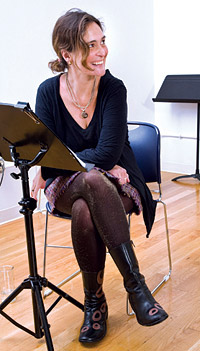When Cusi Cram ’90 was a young child, her mother, British noblewoman Lady Jeanne Campbell, threw a huge party at the family's apartment in Manhattan. Campbell, a trained actress, had been starring in a play at La Mama, a downtown avant-garde theater, and now that the run was over, she'd invited everyone back to her place for a final blowout. "There were drag queens. It had a sort of dolce vita feeling," Cram, who was then five, recalls. "I was kind of scared." She spotted a friendly man in a three-piece suit, hopped onto his lap, and fell asleep. He was Tennessee Williams.

Dusty and the Big, Bad World is about a team of writers and producers behind a kids' TV show who inadvertently step into a political firestorm when they film one of the program's episodes at the home of an eleven-year-old girl with two dads. It's based on a real-life controversy generated by the PBS show Postcards from Buster, which in 2005 shot an episode in the home of a child with two moms. Conservatives condemned the show, whose federal funding suddenly dried up. Cram says she lived in fear at the time that Arthur would become the next target. "It was oddly scary," she says. "It was suddenly like this small thing could catapult into the other direction."
Cram's play A Lifetime Burning focuses on a wealthy WASP writer who makes up a supposedly true memoir in which she claims to be part Inca and part of a family of inner-city crackheads. Cusi's own name means "happy" in Incan, but that's where the resemblance between author and subject ends. The play was inspired by a spate of recent controversies over memoirs that were exaggerated or made up. "There's a strange intersection now between reality and entertainment that I think ultimately is fiction," she says. "We just don't know what to call it."
Cram speaks freely about her celebrity-filled childhood. When her mother was in her twenties, she had a five-year love affair with Henry Luce, the founder of Time and Life, who was thirty years her senior. Campbell went on to cover the Kennedy, Johnson, and Nixon administrations for the British newspaper Daily Express, and in the early 1960s she met and married Norman Mailer, who is the father of Cram's half-sister, Kate Mailer '84. "It was complicated and really fun," Cram says. "I had a good time, even if it was not the most stable environment."
Cram says she did miss some critical parts of childhood. At age thirteen she signed with the Wilhelmina model agency and appeared on the cover of Seventeen several times. Andy Warhol called her "really beautiful" after she posed for his magazine, Interview. Cram says she modeled to cover tuition at the private high school she attended in Manhattan and, later, at Brown. "I actually was quite shy," she says, which made her uncomfortable with her modeling fame.
Her childhood also taught her "what the downside of fame was," and she says her sense of growing up too quickly informs her writing for Arthur. "I think I am very conscious of having a somewhat abbreviated childhood," she says. "I'm pretty in touch with the childlike aspects of myself."
Cram, whose mother died in 2007, says she is now thinking of writing a book about her. "After the run of [A Lifetime Burning], I am not sure how I want to tell my mother's story," she says. "I am certain it will become something, but whether it is fact or fiction remains to be seen."




